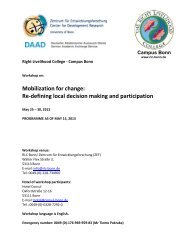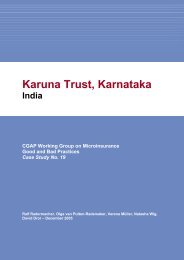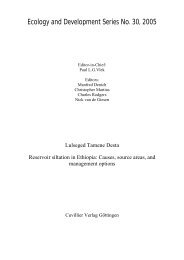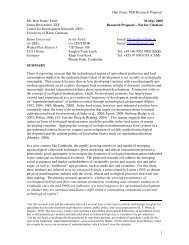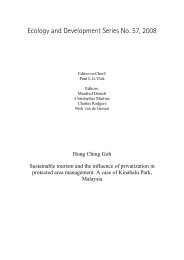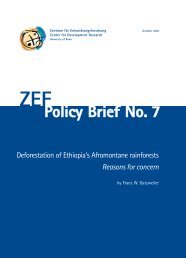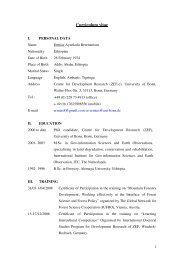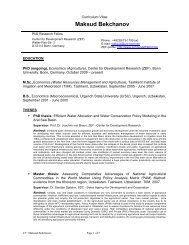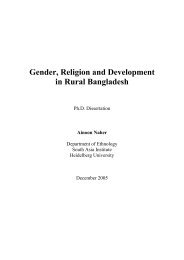Ecology and Development Series No. 10, 2003 - ZEF
Ecology and Development Series No. 10, 2003 - ZEF
Ecology and Development Series No. 10, 2003 - ZEF
- No tags were found...
Create successful ePaper yourself
Turn your PDF publications into a flip-book with our unique Google optimized e-Paper software.
Current state of knowledgeHailu, undated, unpublished proposal). Accordingly, Yayu forest was one of the c<strong>and</strong>idatesites proposed for conservation. However, these efforts have not gone far beyond theproposal stage. In 1998, the Coffee Improvement Project of Ethiopia proposed theestablishment of three C. arabica gene reserves in southwest Ethiopia (Demel et al. 1998;Paulos <strong>and</strong> Demel 2000). The sites selected were the Berhane-Kontir (ca. 9,000 ha),Boginda-Yeba (ca. 3,000 ha), <strong>and</strong> Yayu (ca. <strong>10</strong>,000 ha) forests. Complementary, ex situconservation in different agro-ecological zones was also proposed. However, little wasdone to practically implement these proposals.The three forest areas proposed as gene reserves were selected based solely ontheir accessibility <strong>and</strong> consideration of financial constraints regarding the conservation ofmore sites. There are about five forest areas with known occurrences of wild coffeepopulations, which could be equally important for conservation. Additional sites known tohave wild coffee populations include: Amora-Gedel, Dawo-Tobi, Bale mountains,Mankera, <strong>and</strong> Maji.On-farm <strong>and</strong>/or homegarden conservationFarm-based conservation involves the maintenance of traditional crop varieties or croppingsystems by farmers within the traditional agricultural systems. On the traditional farms <strong>and</strong>homegardens, the l<strong>and</strong> races are sown <strong>and</strong> harvested. Each season, the farmers keep aproportion of the harvested seed for re-sowing. Thus, the l<strong>and</strong> race is highly adapted to thelocal environment <strong>and</strong> is likely to contain locally adapted alleles that may prove useful forspecific breeding programs.The overall advantage of this method is that it ensures the maintenance of ancientl<strong>and</strong> races <strong>and</strong> those wild species dependent on traditional agriculture. However, the l<strong>and</strong>races may yield less than modern cultivars <strong>and</strong> the farmers may require subsidizing <strong>and</strong>possibly monitoring to ensure continued cultivation. Contemporary economic forces tend toact against the continued cultivation of ancient l<strong>and</strong> races, which are undoubtedly sufferingrapid genetic erosion, if not facing extinction (Dulloo et al. 1998). However, the rate ofgenetic erosion in coffee compared to annual crops is presumed to be lower, since coffee is25



